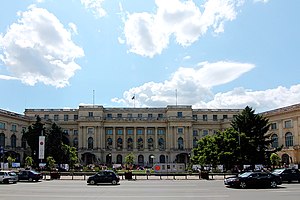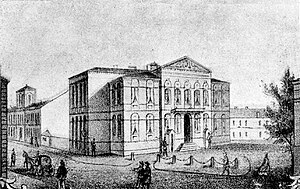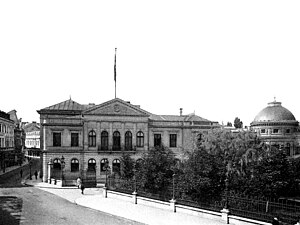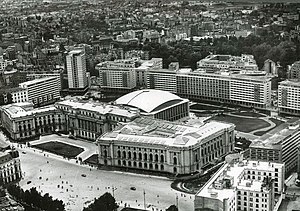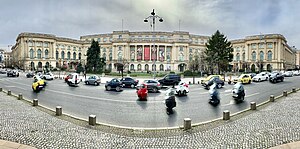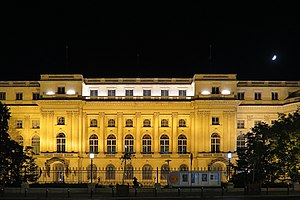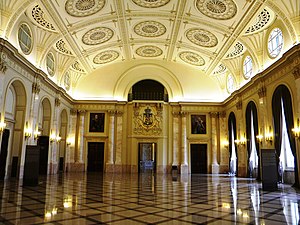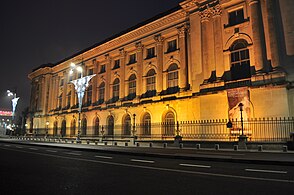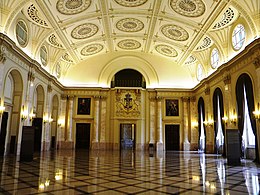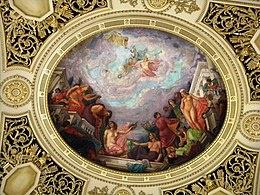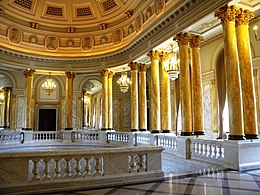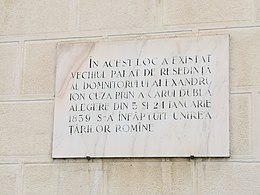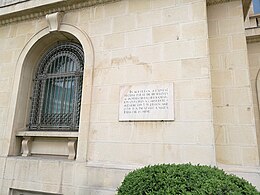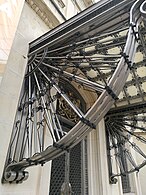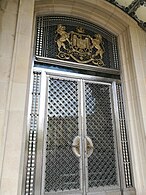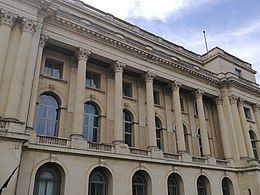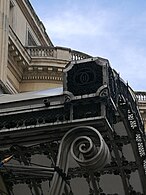
Elisabeth of Romania was a princess of Romania and member of the House of Hohenzollern-Sigmaringen and by marriage Queen of Greece during 1922–1924, as the wife of King George II of Greece.

The Senate is the upper house in the bicameral Parliament of Romania. It has 136 seats, to which members are elected by direct popular vote using party-list proportional representation in 43 electoral districts, to serve four-year terms.
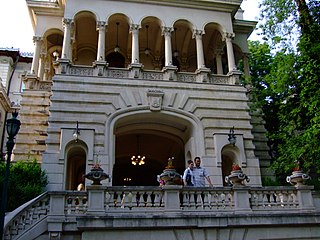
Cotroceni Palace is the official residence of the President of Romania. It is located at Bulevardul Geniului, nr. 1, in Bucharest, Romania. The palace also houses the National Cotroceni Museum.
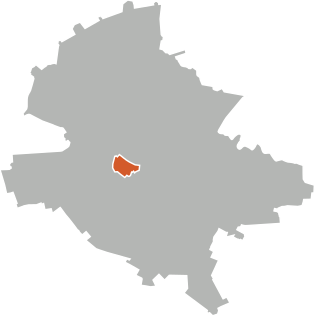
Cotroceni is a neighbourhood in western Bucharest, Romania located around the Cotroceni hill, in Bucharest's Sector 5.

Margareta, Custodian of the Crown of Romania is the eldest daughter of King Michael I and Queen Anne of Romania. She assumed her father's duties in March 2016, upon his retirement, and has claimed the headship of the House of Romania since his death on 5 December 2017. She also heads the Margareta of Romania Royal Foundation.

Telephones Company Building is an Art Deco office building located on Calea Victoriei in Bucharest, Romania. It is now owned by Telekom România.
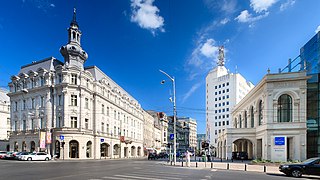
Calea Victoriei is a major avenue in central Bucharest. Situated in Sector 1, and having a length of 2.7 kilometres (1.7 mi), it leads from Splaiul Independenței to the north and then northwest up to Piața Victoriei, where Șoseaua Kiseleff continues north.

Șoseaua Kiseleff is a major road in Bucharest, Romania. Situated in Sector 1, the boulevard runs as a northward continuation of Calea Victoriei.

Nicholas Michael de Roumanie Medforth-Mills, formerly called Prince Nicholas of Romania, is the eldest child and only son of Princess Elena of Romania and Robin Medforth-Mills. As a grandson of King Michael of Romania, he was third in line to the defunct throne of Romania according to a new family statute enacted in 2007, that also conferred the title of a "prince of Romania" on him which was removed in 2015. The statute and the titles it confers have no standing in present Romanian law.

Victory Square is one of the major public squares in Bucharest, Romania, an intersection where Calea Victoriei, Lascăr Catargiu Boulevard, Iancu de Hunedoara Boulevard, Kiseleff Boulevard, Ion Mihalache Boulevard, and Nicolae Titulescu Boulevard cross.
Revolution Square is a square in central Bucharest, on Calea Victoriei. Known as Palace Square until 1989, it was renamed after the Romanian Revolution of December 1989. The former Royal Palace, the Athenaeum, the Athénée Palace Hotel, the University of Bucharest Library and the Memorial of Rebirth are located here. The square also houses the building of the former Central Committee of the Romanian Communist Party. In 1990, the building became the seat of the Senate and since 2006 it houses the Ministry of Interior and Administrative Reform.
Romanian architecture is very diverse, including medieval, pre-World War I, interwar, postwar, and contemporary 21st century architecture. In Romania, there are also regional differences with regard to architectural styles. Architecture, as the rest of the arts, was highly influenced by the socio-economic context and by the historical situation. For example, during the reign of King Carol I (1866–1914), Romania was in a continuous state of reorganization and modernization. In consequence, most of the architecture was designed by architects trained in Western European academies, particularly the École des Beaux-Arts, and a big part of the downtowns of the Romanian Old Kingdom were built during this period.

Elisabeta Palace is a palace on Kiseleff Road in Bucharest, Romania. Built in 1936, it is the official residence in Romania of Margareta of Romania, her husband Prince Radu, and her sister Princess Maria.

The CEC Palace in Bucharest, Romania, built between 8 June 1897 and 1900, and situated on Calea Victoriei opposite the National Museum of Romanian History, is the headquarters of CEC Bank.
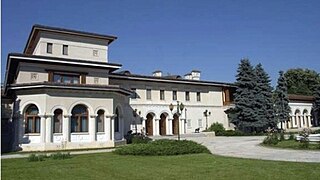
Snagov Palace is a former royal palace on the shore of Lake Snagov, about 40 km north-east of Bucharest, in Ilfov County, Romania. The palace is situated in the commune of Snagov and near the Snagov monastery.
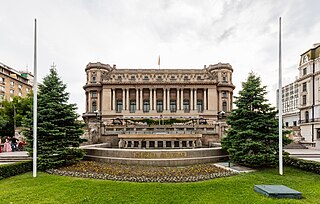
The Palace of the National Military Circle, also known as the Officers' Circle Palace is located on Constantin Mile street in Bucharest, Romania. It was built in 1911, based on plans drawn by chief architect Dimitrie Maimarolu, using French neoclassical style. The beneficiary was the Officers' Circle of the Bucharest military garrison, which was founded in 1876.

Alexandru Săvulescu (1847–1902) was a Romanian architect, one of his country's first prominent practitioners of modern architecture. He combined elements of traditional Byzantine architecture and Romanian architecture with French Art Nouveau in an eclectic style. He served as the chief architect for the Ministry of Public Education and Religious Affairs and the president of the Romanian Society of Architects. He helped found both the latter organization and the Romanian National School of Architecture. Some of his most renowned buildings are the Communal Palace of Buzău, the Noblesse Palace and the Post and Telegraph Palace, which now houses the National Museum of Romanian History.

Casa Nouă was a villa in Bucharest, Romania, used as a Royal residence. It was situated at 24, Pictor Grigorescu Street, behind the Royal Palace, on the site where Sala Palatului Concert Hall now stands.
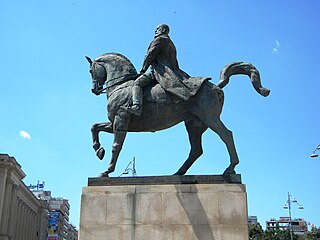
The equestrian statue of Carol I is a monument in Romania, situated in the central zone of Bucharest, on Calea Victoriei.

Romanian Revival architecture is an architectural style that has appeared in late 19th century in Romanian Art Nouveau, initially being the result of the attempts of finding a specific Romanian architectural style. The attempts are mainly due to the architects Ion Mincu (1852–1912), and Ion N. Socolescu (1856–1924). The peak of the style was the interwar period. The style was a national reaction after the domination of French-inspired Classicist Eclecticism. Apart from foreign influences, the contribution of Romanian architects, who reinvented the tradition, creating, at the same time, an original style, is manifesting more and more strongly. Ion Mincu and his successors, Grigore Cerchez, Cristofi Cerchez, Petre Antonescu, or Nicolae Ghica-Budești declared themselves for a modern architecture, with Romanian specific, based on theses such as those formulated by Alexandru Odobescu around 1870:
"Study the remains – no matter how small – of the artistic production of the past and make them the source of a great art (...) do not miss any opportunity to use the artistic elements presented by the Romanian monuments left over from old times; but transform them, change them, develop them ..."
